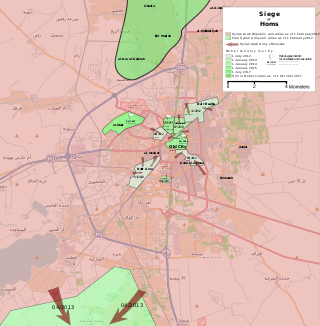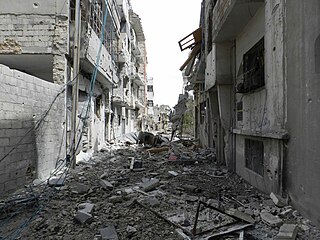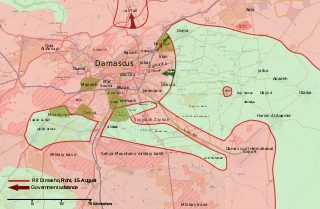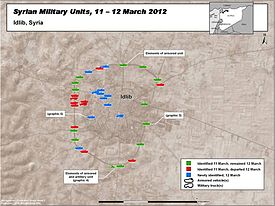The following is a timeline of the Syrian Civil War from May to August 2011, including the escalation of violence in many Syrian cities.

The siege of Homs was a military confrontation between the Syrian military and the Syrian opposition in the city of Homs, a major rebel stronghold during the Syrian Civil War. The siege lasted three years from May 2011 to May 2014, and ultimately resulted in an opposition withdrawal from the city.

The 2011–2013 Daraa Governorate clashes are a series of military confrontations between the Syrian Army and the Free Syrian Army in Daraa Governorate, Syria, which began in November 2011, after widescale protests and crackdown on protesters in Daraa had lasted since April 2011. The clashes had been ongoing as part of the Syrian civil war, until the U.N. brokered cease fire came into effect on 14 April 2012. Sporadic clashes continued since then, however.
The Rif Dimashq clashes were a series of unrests and armed clashes in and around Damascus, the capital of Syria, from November 2011 until a stalemate in March 2012. The violence was part of the wider early insurgency phase of the Syrian civil war. Large pro-government and anti-government protests took place in the suburbs and center of Damascus, with the situation escalating when members of the Free Syrian Army (FSA) started attacking military targets in November.

The 2012 Aleppo Governorate clashes were a series of battles as part of the early insurgency phase of the Syrian civil war in the Aleppo Governorate of Syria.

The September 2011 – March 2012 Idlib Governorate clashes were the violent incidents that took place in Idlib Governorate, a province of Syria, from September 2011 and prior to the April 2012 Idlib Governorate Operation.
The following is a timeline of the Syrian Civil War from January to April 2012, during which time the spate of protests that began in January 2011 lasted into another calendar year. An Arab League monitoring mission ended in failure as Syrian troops and anti-government militants continued to do battle across the country and the Syrian government prevented foreign observers from touring active battlefields, including besieged opposition strongholds. A United Nations-backed ceasefire brokered by special envoy Kofi Annan met a similar fate, with unarmed UN peacekeepers' movements tightly controlled by the government and fighting.
The Battle of Zabadani took place in January through February 2012, during the Syrian Civil War. During the initial stages of the battle, the rebel FSA took control of the town. However, less than a month later, the Army retook control of Zabadani, forcing rebel fighters to withdraw towards the Lebanese border.

A second battle between the Syrian Army and the Free Syrian Army for control of the city of Rastan took place from 29 January to 5 February 2012. Located in Homs Governorate, Rastan is a city of 60,000 residents. The FSA captured Rastan after days of intense fighting, according to residents and the opposition.

The 2012 Homs offensive was a Syrian Army offensive on the armed rebellion stronghold of Homs, within the scope of the Siege of Homs, beginning in early February 2012 and ending with the U.N. brokered cease fire on 14 April 2012.

The first of the two battles in al-Qusayr was fought by the Syrian army and Shabiha against the Free Syrian Army in the small city of Al-Qusayr, near Homs, during late winter and spring of 2012.
The Hama Governorate clashes were a series of incidents of fighting during late 2011 and early 2012 in the Syrian Governorate of Hama, as part of the Early insurgency phase of the Syrian Civil War.
The following is a timeline of the Syrian Civil War from May to August 2012. The majority of death tolls reported for each day comes from the Local Coordination Committees, an opposition activist group based in Syria, and the Syrian Observatory for Human Rights, another opposition group based in London.

The Battle of Damascus, also known as Operation Damascus Volcano, started on 15 July 2012 during the Syrian civil war. It is unclear who started the battle. Thousands of rebels infiltrated Damascus from the surrounding countryside. Following this, according to some reports, the opposition forces launched an operation to capture the capital, while according to other reports, the military learned of the large-scale rebel operation beforehand and made a preemptive strike. Some reports even suggested the rebels launched the operation prematurely due to their plans being discovered by the security forces.

The Rif Dimashq offensive was a Syrian Army offensive in the Rif Dimashq Governorate during August–October 2012, as part of the Syrian Civil War.

The Battle of Maarat Al-Numan took place between the Syrian Army and the rebel Free Syrian Army for control of the strategically important town of Maarrat al-Numan in October 2012, during the Idlib Governorate clashes of the Syrian Civil War.

The siege of Wadi Deif refers to the siege of two Syrian Army bases, Wadi Deif and Hamadiyah, by rebel forces, starting on 11 October 2012, during the Idlib Governorate clashes of the Syrian civil war.

The June 2012–April 2013 Idlib Governorate clashes was a series of clashes within the scope of the Syrian civil war, that took place in Syria's Idlib Governorate. The events followed the April 2012 Idlib Governorate Operation by the Syrian government and consequent cease-fire attempt, which had lasted from 14 April to 2 June 2012.

The Battle of Idlib was a military operation in the Idlib Governorate, during the Syrian Civil War, conducted by rebels against Syrian government forces defending Idlib city.

The early insurgency phase of the Syrian civil war lasted from late July 2011 to April 2012, and was associated with the rise of armed oppositional militias across Syria and the beginning of armed rebellion against the authorities of the Syrian Arab Republic. Though armed insurrection incidents began as early as June 2011 when rebels killed 120–140 Syrian security personnel, the beginning of organized insurgency is typically marked by the formation of the Free Syrian Army (FSA) on 29 July 2011, when a group of defected officers declared the establishment of the first organized oppositional military force. Composed of defected Syrian Armed Forces personnel, the rebel army aimed to remove Bashar al-Assad and his government from power.













